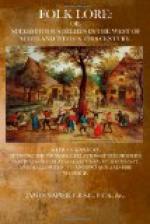Child Rowland drew his good claymore (excalibar) that never struck in vain. A furious combat ensued, and the king was defeated; but Child Rowland spared his life on condition that he would free his sister, Burd Ellen, and his two brothers, who were lying in a trance in a corner of the hall. The king then produced a small crystal phial containing a bright red liquor, with which he anointed the lips, nostrils, ears and finger tips of the two brothers, who thereupon awoke as from a profound sleep, and all four returned in triumph to “merry Carlisle.” The Rev. Mr. Kirk’s descriptions of the subterranean homes of the fairies and of their social habits are just the counterparts of the fairyland of this beautiful ballad legend. There can be little doubt that such beliefs are but survivals in altered form of what were in still more ancient times religious tenets. What were formerly divinities have given place to the more lowly fairies, brownies, &c., and from the position of Pagan gods they have, through the opposing influence of Christianity, been removed to the other side, and became servants of the devil, actively opposing the kingdom of Christ. Some have supposed that the fairies may have originally been considered to be descendants of the Druids, for some reason consigned to inhabit subterranean caves under green hills in wild and lonely glens. Others have identified them with the fallen angels. One thing is certain, that the notion that there exists supernatural men, women, and animals who inhabit subterranean and submarine regions, and yet can indulge in intercourse with the human race, is of very great antiquity, and widely spread, existing in Arabia, Persia, India, Thibet, among the Tartars, Swedes, Norwegians, British, and also among the savage tribes of Africa. In the west of Scotland there was a class of fairies who acted a friendly part towards their human neighbours, helping the weak or ill-used, and generally busying themselves with acts of kindness; these were called “brownies.” The fairies proper were a merry race, full of devilment, and malicious, tricky, and troublesome, and the cause of much annoyance and fear among the people. Besides these supernatural beings—brownies, fairies, &c.—there existed a belief in persons who were possessed of supernatural powers—magicians, sorcerers, &c. About the Reformation period, these persons were considered to be in the actual service of the devil, who was then thought to be raising a more determined opposition than ever to the spread of the kingdom of God, and adopting the insidious means of enlisting men and women into his service by conferring upon them supernatural powers; so that by this contract they were bound to do mischief to all good Christian people; and the more mischief they could do the greater would be the favours they received from their master. This belief was not confined to the ignorant, but was equally accepted by the educated and by the Church. Measures were taken to frustrate the devil, and the




